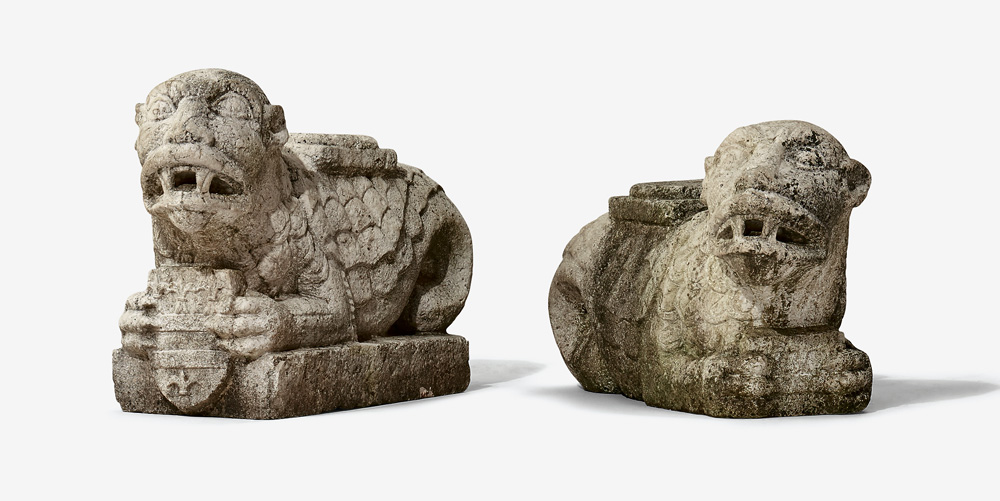A pair of Sicilian 17th century marble sculptures

738. A pair of Sicilian 17th century marble sculptures
Probably around 1600‑1625. Each depicting a winged sea-lion, one on a base, holding a heraldic shield.
Marble. Height 44.5‑50 cm, Lenght 77 cm.
SEK 30.000 – 40.000 € 3.100 – 4.100
Two marble sculptures in the shape of winged sea-lions, with lion heads, scaled bodies, folded wings and curving fish tails, with socles and bases for columns on their backs and holding coats of arms in their forepaws. The coat of arms depicts three fleurs de lis above two fesses with another fleur de lis at the bottom.
The mythological sea-lion or leocamp, also known as morse or merlion, is known from antiquity and associated with hippocamps, tritons, nereids and other sea creatures. They became very scarce during the middle ages, but saw a revival during the renaissance, and became increasingly popular during the baroque era. It occurs as the symbol of Spanish realms overseas, ultramar, including Sicily, and is still incorporated in the flag of Manila.
The present sculptures with their frontal postures and stylized features are reminiscent of the many column bearing lions, stilofori, from Italy’s romanesque cathedrals. Stylistically these sculptures combine baroque features with gothic traces such as the shape of the shields, the stylized faces, and the rigid posture. Taken together these features point to a date in the beginning of the baroque development, around 1600. Their marine and aquatic connotations of the iconography suggest however that the sculptures once formed parts of a water fountain.
From the middle of the 16th century through the 17th fountains became subject of extravagant designs, not all of which equal the famous fountains in Piazza Navona or Fontana di Trevi in Rome. In Sicily’s arid landscape, the supply of public water was of vital importance, and the roman aqueducts were maintained into early modern time, with flamboyant fountains erected in public piazzas during the 16th and 17th centuries as symbolic manifestations of benevolence of the Spanish rulers.
The names of the local administrators and commissioners were inscribed on many fountains, analogous to the coats of arms on the present sea-lions. A similarly shield-holding lion can be seen in front of the bishop’s throne inside the cathedral of Taormina, and in heraldry, sea-lions occur as shield supporters.
The hippocampi of the well-known fountain of the piazza del Duomo in Taormina (1635) and the fountain of the two dragons in Palermo (1630) by Mariano Smiriglio exemplify different structures which incorporate similar water creatures. Closer stylistic affinities can be found at the fountain of Saturn in Trapani (1603) and even closer are the mascarons of the fountain of Piazza Umberto I in Palazzo Adriano (1608) outside Palermo, sculpted by Nicolò Gagliano and Vito Termini.
The coat of arms has not yet been identified, although Sicilian families lika Raffa, Bolognetti, Broccardo, Allegra, show many similar elements. With further research, however, chances to reach a definitive identification are good, and if so, the possibility to identify the dismantled fountain itself should not be ruled out. The Taormina provenance from the 1950’s gives a good point of departure, and it seems likely that the origin of the present sculptures should be expected in that region.
Thomas Bergqvist Rydén, PhD